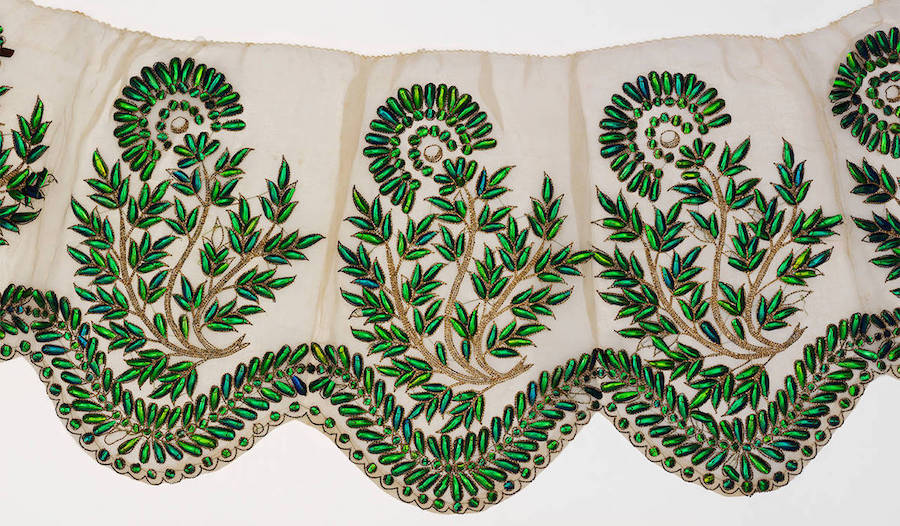
PIECES OF GOLD AND SILVER
Image: Courtesy of V&A Museum, muslin embroidered with beetle wings and couched gold wire. makers unknown. 19th century.
Text: Nidhi Garg Allen
Zardozi is sometimes also called 'karchobi' or 'adda'— a framework —and this is the primary tool in zardozi embroidery. As a technique, zardozi is more akin to metallic appliqué work than embroidery. In all other embroidery techniques, more pliable yarns like cotton, silk, wool, or linen are used to make stitches on the surface of the fabric. In zardozi, by contrast, the thread is used only to bind various raw materials to the fabric's surface.
Apart from the gold-based thread, many simpler raw materials come together to make a beautiful piece of zardozi embroidery. For example, the Indian peninsula is rich in beetles, and these insects possess shiny, hard, protective wings in lustrous jewel tones. These wings are sometimes used as a raw material, along with precious stones, for zari embroidery.
The metallic threads, coils, stones, and beads are laid on the fabric's surface, covering the design's tracings. A thread tacks these materials to the surface of the fabric with the help of a needle.

Image: Crown of Persian ruler Bahadur Shah Zafar
Later, the aari (a unique hook needle) was introduced. The aari technique is worked with the kasab thread we learned about earlier this week, instead of gold thread. The other distinctive zardozi technique is 'kamdani'. Kamdani is a metalwork technique, wherein a flattened metallic wire, called 'badla taar,' is pierced through the cloth or threaded with a needle and twisted to create patterns.
The most special zardozi technique is couching, known as ‘vasli’ in Hindi. This method creates an embossed embroidery effect on the fabric. Areas where the embossing is required are filled with cotton stitches, foam, or another soft, shaped filling, then covered with zari wires or coils.

Image: Couching or vasli work
Minakari— so named for its bright, enamelled look —is a zardozi fashion in which many colourful silk threads are used along with the zari.
Traditionally, zardosi was added to a base of silk or velvet. However, later European influences made net, tissue, and georgette popular.
Nidhi Garg Allen is an alumnus of Parsons School of Design and Adjunct Professor at the Fashion Institute of Technology. A technologist turned artisan entrepreneur, she is the founder and CEO of Marasim. Marasim emerged from Nidhi’s curiosity for the history and beauty of her own Indian culture, with craftsmanship and textiles her medium of inquiry. Based in New York, Marasim is now committed to preserving artisanal textiles that use regional techniques, without uprooting craftspeople from their native communities. Marasim designs and develops high-quality products, in collaboration with traditional Indian artisans, for luxury designers, such as Gabriela Hearst, Tory Burch, Oscar de la Renta, and Bode.
